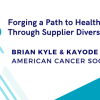5 Benefits to Adding Sustainability Measures in Your Contracts (and How to Get Started)
Jane Zhang and Naz Rahman, ETCH Sourcing
The value creation challenges we faced decades ago are the same that organizations still grapple with today. The main difference, however, is that the rate of innovation is accelerating daily. So, although studying the past should be a part of your strategy, we need to be careful it does not become a comfortable crutch. We cannot chart a path forward by looking backwards.
In this fast-paced environment, we see the innovation of all forms for value-creation that leads the industry to speed through its life cycles at an extraordinary rate. So, how can modern organizations to keep up? Through integrating sustainable measures.
For the uninitiated, the concept of sustainable procurement may feel like a laborious and often daunting process. However, executives who are keen on competing understand that time invested in sustainable practices is time well spent. Including sustainable measures in your negotiations and contracts doesn't have to be time intensive. In this article, we will walk you through five benefits to building sustainable measures into your contracts and how to do so effectively.
1. Strengthened Long-Term Business Strategy
Strategies are made stronger with sustainability. In today's competitive environment, no organization can successfully grow and endure the landscape without integrating sustainability into its strategy. Sustainability is a business approach to long-term value creation in how organizations operate socially and environmentally. Leaders need to ensure that their organization’s strategy and values are reflected throughout its efforts – this includes its contracts.
Leaving sustainability on the backburner can hamper your ambitions to advance, which may cause you to lose clients. Not only will a lack of sustainable strategy impact your bottom line, but you may also feel the impacts on your brand, culture and talent.
Best Practice
Build and execute strategies that ensure effective implementation by leveraging stakeholder collaboration, go-to-market tactics and negotiation strategies. Begin with identifying what sustainability objectives are essential to your organization. Then, be sure to establish measurable reporting metrics with your suppliers.
2. Proactive Risk Management and Contingency Planning
Be proactive rather than reactive. Incorporating sustainability into your contracts can inspire a greater purpose among your suppliers to open new doors to innovation, new markets and build trust among stakeholders. All while future-proofing your organization.
COVID-19 revealed significant challenges with supply chains that were over-reliant on offshore suppliers. By localizing your supply base and contributing to the development of local businesses, organizations can also de-risk their supply chain dependence on overseas productions.
Best Practice
Identify opportunities by leveraging your current strategic direction in conjunction with past, present and forecasted trends. This will help you to identify actionable projects that can increase operational efficiencies, drive value creation and push sustainability objectives.
3. Increased Brand Power and Organizational Citizenship
Even though numerous companies believe that sustainability is an area of competitive advantage, only 24% have acted on this belief. This low adoption rate is both alarming and an opportunity for today’s industry leaders to create waves in today’s industry standards. Compliance is holistic. It is not just a “nice to have” but a “must-do.” Consumers today are pushing brands to be compliant to be considered. Therefore, a move toward adopted sustainable practices is crucial to building a long-lasting brand.
Leaders who anticipate this change and embrace it as an opportunity will not just imagine the future; they will create it! Remember, change is not possible without the right talent to drive it. Therefore, to enable a positive change, you must identify your internal champions. Empower them, create and lead new initiatives, and inspire those around them.
Best Practice
Enhance and invest in supplier development programs that will allow for a sustainable growth strategy. These opportunities encourage participation from local suppliers and entrepreneurs and has the added benefit of strengthening your local supply chain and brand recognition. Training, mentoring, and access to resources boost supplier capabilities and drive continuous business growth, while increasing customer loyalty.
4. End-to-End Supply Chain Transparency
As consumer expectations increase and transparency becomes more demanding, organizations need to act sustainably throughout every step of their supply chain. This is the bare minimum. Greenwashing is no longer acceptable.
Transparency is vital for assessing and improving sustainability practices. You cannot judge without transparency. Open environments not only help to establish transparency but also lend themselves well to aligning stakeholders. The key to transparency among suppliers and stakeholders is open communications. Approach this with the values of disclosure, clarity, accuracy and accountability.
Best Practice
Manage supplier relationships and performance to ensure contract compliance and integrate sustainability KPIs into supplier relationship management (SRM). This approach captures and allows for reportable and measurable results that can be reiterated and improved upon during annual evaluations. Sustainable procurement is about more than just checking the box, it is about creating tangible and measurable impact in the world you operate in.
5. Embrace and Empower Supplier Diversity
There is no one-size-fits-all approach. Every organization varies, with distinct goals and scope. This means that just because one supplier worked for an opportunity does not mean it will work for the next.
Welcoming new suppliers also brings a diversity of thought to the table. You can tap into their unique insights and leverage a strategic partner you may not have had before. Keeping your doors open in the discovery process leads to a higher return on investment (ROI) from their procurement, lowers operating costs and lowers supply chain risk.
Best Practice
When analyzing categories of spend that are typically high risk, look for opportunities to provide a carve out to explore diverse suppliers. For example, a call center agreement that captures both external client-facing services as well as internal organization-facing services may be split to allow for fair competition among smaller diverse suppliers with lower risk services such as internal services.
Conclusion
The bottom line is that doing good is good for business. The hurdles of sustainability are not as daunting as it seems. Many business problems in today's market have been seen for hundreds of years and can be solved with a strong foundation of supplier contracts that are well balanced and set clear expectations while delivering lasting value to all parties. Integrating sustainability into your contracts creates actionable, tangible and measurable impact. In order to get ahead tomorrow, you must start moving today.
Need ideas on where to start? We have created an open-sourced tool with a library of sustainable procurement ideas along with step-by-step walk-throughs that connect the United Nations Sustainability Development Goals (UNSDGs) to popular spend categories.










